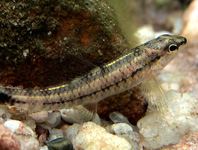Abstract
A new species group, the brevis-group, is established for two new species of the fig wasp genus Sycophaga Westwood (Hymenoptera: Agaonidae) reared from the monoecious fig tree Ficus orthoneura (Moraceae, Ficus, subgenus Urostigma) in China. The two new species, S. brevis n. sp. and S. diutius n. sp. are described and illustrated, supplemented by COI sequence data. In contrast with two other species groups newly recognized in Sycophaga, the explorator-group for species previously classified in Apocryptophagus Ashmead and the sycomori-group for other species previously classified in Sycophaga, the brevis-group is uniquely defined by the long pronotum of females and a Ficus host within the subgenus Urostigma.
References
Berg, C.C. & Wiebes, J.T. (1992) African fig trees and fig wasps. Koninklijke Nederlandse Akademie van Wetenschappen Verhandelingen Afdeling Natuurkunde, Tweede reeks, North-Holland, Amsterdam, Oxford, New York, Tokyo, 298 pp.
Bouček, Z. (1988) Australasian Chalcidoidea (Hymenoptera). A biosystematic revision of genera of fourteen families, with a reclassification of species. C.A.B. International, Wallingford, 832 pp.
Cruaud, A., Jabbour-Zahab, R., Genson, G., Couloux, A., Peng, Y.Q., Rong, Y.D., Ubaidillah, R., Pereira, R.A.S., Kjellberg, F., van Noort, S., Kerdelhue, C. & Rasplus, J.Y. (2011a) Out of Australia and back again: the world-wide historical biogeography of non-pollinating fig wasps (Hymenoptera: Sycophaginae). Journal of Biogeography, 38, 209–225.
http://dx.doi.org/10.1111/j.1365-2699.2010.02429.xCruaud, A., Jabbour-Zahab, R., Genson, G., Kjellberg, F., Kobmoo, N., van Noort, S., Da-Rong, Y., Yan-Qiong, P., Ubaidillah, R., Hanson, P., Santos-Mattos, O., Farache, F., Pereira, R., Kerdelhue, C. & Rasplus, J.-Y. (2011b) Phylogeny and evolution of life-history strategies in the Sycophaginae non-pollinating fig wasps (Hymenoptera, Chalcidoidea). BMC Evolutionary Biology, 11(178), 1–16.
http://dx.doi.org/10.1186/1471-2148-11-178Farache, F.H.A. & Rasplus, J.Y. (2015) Conidames, a new oriental genus of Sycophaginae (Hymenoptera, Agaonidae) associated with Ficus section Conosycea (Moraceae). Zookeys, 539, 119–145.
http://dx.doi.org/10.3897/zookeys.539.6529Hall, T.A. (1999) BioEdit: a user-friendly biological sequence alignment editor and analysis program for Windows 95/98/NT. Nucleic Acids Symposium Series, 41 (1999), pp. 95–98,
Hebert, P.D., Penton, E.H., Burns, J.M., Janzen, D.H. & Hallwachs, W. (2004) Ten species in one: DNA barcoding reveals cryptic species in the neotropical skipper butterfly Astraptes fulgerator. Proceedings of the National Acadamy of Sciences of the United States of America, 101, 14812–14817.
http://dx.doi.org/10.1073/pnas.0406166101Kerdelhue, C. & Rasplus, J.-Y. (1996) Non-pollinating Afrotropical fig wasps affect the fig-pollinator mutualism in Ficus within the subgenus Sycomorus. Oikos, 75, 3–14.
http://dx.doi.org/10.2307/3546315Kerdelhue, C., Rossi, J.-P. & Rasplus, J.-Y. (2000) Comparative community ecology studies on old world figs and fig wasps. Ecology, 81, 2832–2849.
http://dx.doi.org/10.1890/0012-9658(2000)081[2832:CCESOO]2.0.CO;2Li, Y., Zhou, X., Feng, G., Hu, H., Niu, L., Hebert, P.D. & Huang, D. (2010) COI and ITS2 sequences delimit species, reveal cryptic taxa and host specificity of fig-associated Sycophila (Hymenoptera, Eurytomidae). Molecular Ecology Resources, 10, 31–40.
http://dx.doi.org/10.1111/j.1755-0998.2009.02671.xTamura, K., Peterson, D., Peterson, N., Stecher, G., Nei, M. & Kumar, S. (2011) MEGA5: molecular evolutionary genetics analysis using maximum likelihood, evolutionary distance, and maximum parsimony methods. Molecular Biology and Evolution, 28, 2731–2739.
http://dx.doi.org/10.1093/molbev/msr121

